The Intel Core i7-7700K (91W) Review: The New Out-of-the-box Performance Champion
by Ian Cutress on January 3, 2017 12:02 PM ESTProfessional Performance: Windows
Agisoft Photoscan – 2D to 3D Image Manipulation: link
Agisoft Photoscan creates 3D models from 2D images, a process which is very computationally expensive. The algorithm is split into four distinct phases, and different phases of the model reconstruction require either fast memory, fast IPC, more cores, or even OpenCL compute devices to hand. Agisoft supplied us with a special version of the software to script the process, where we take 50 images of a stately home and convert it into a medium quality model. This benchmark typically takes around 15-20 minutes on a high end PC on the CPU alone, with GPUs reducing the time.
Here we report the overall time to complete the test – sub-test results can be found in Bench.
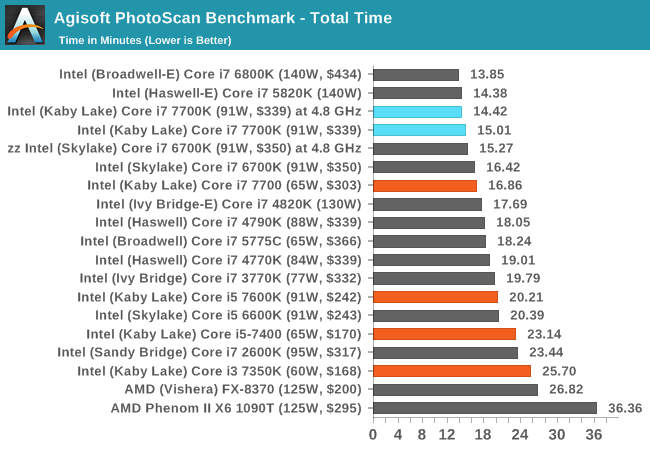
Here’s another instance where a stock Core i7-7700K can overcome an overclocked Devil’s Canyon. Agisoft spends a good time of its workload using cache heavy threads, showing that large core parts do really well, however the i7-7700K is on par with the six-core Core i7-3960X, showing that extra IPC and frequency can make up for a core or two.
Cinebench R15
Cinebench is a benchmark based around Cinema 4D, and is fairly well known among enthusiasts for stressing the CPU for a provided workload. Results are given as a score, where higher is better.
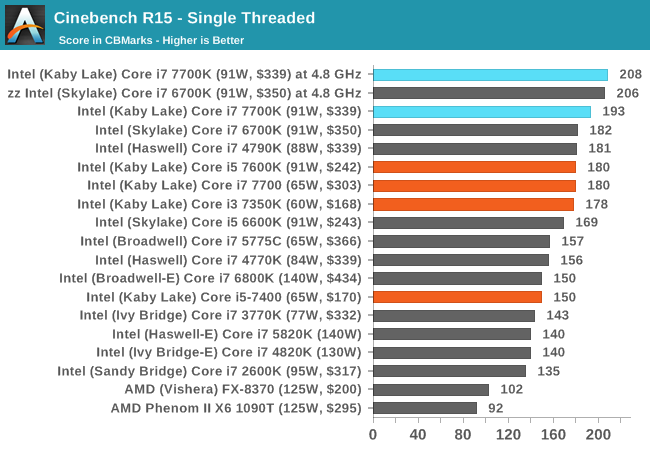
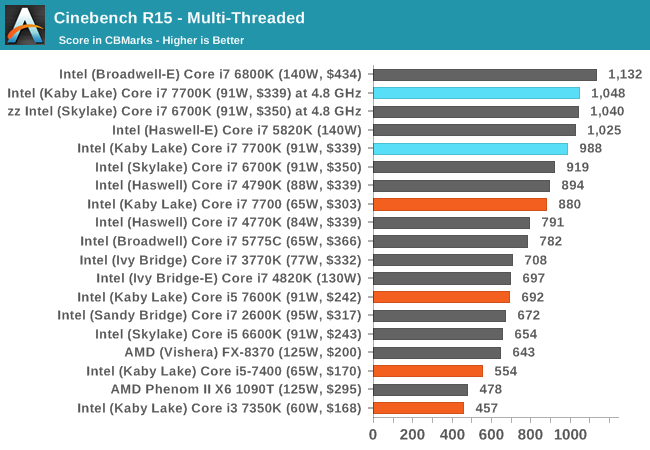
While Cinebench R15 is more a synthetic, it remains a popular test to measure professional performance and is free to use. For single threaded performance, the Core i7-7700K hits the top of the pile. With the Skylake and Kaby Lake parts both at 4.8 GHz, there’s almost nothing between them, showing the identical IPC. In multithreaded mode the 7700K is on top of all the mainstream processors as expected, and when overclocked can mix it up with some of the extreme processors as well.
HandBrake v0.9.9: link
For HandBrake, we take two videos (a 2h20 640x266 DVD rip and a 10min double UHD 3840x4320 animation short) and convert them to x264 format in an MP4 container. Results are given in terms of the frames per second processed, and HandBrake uses as many threads as possible.

The LQ video emphasizes IPC due to its low cache overhead, meaning that the i7-7700K wins again, and when overclocked, performs the same as the 6700K at the same frequency.
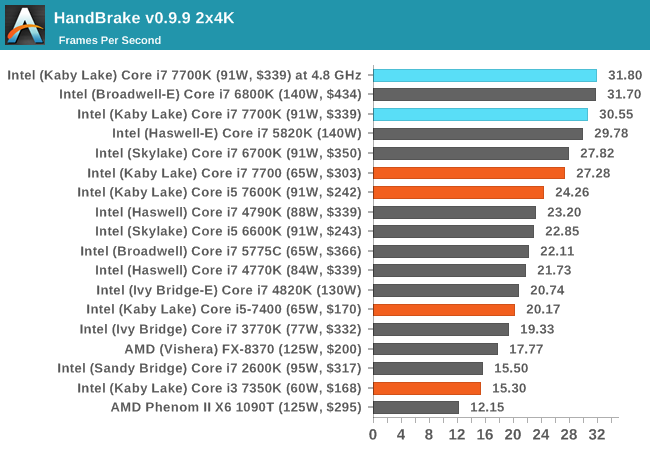
The higher resolution video however means that cores with frequency dominate. The i7-7700K stands above processors such as the i7-5820K, the i7-4930K and the i7-3960X, which is no small feat. But if you really want performance here, the big boys are still top performers (if you can afford them).
Hybrid x265
Hybrid is a new benchmark, where we take a 4K 1500 frame video and convert it into an x265 format without audio. Results are given in frames per second.
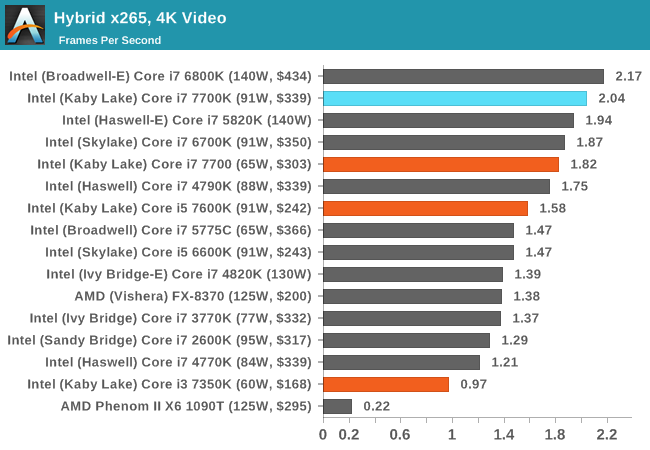
Our Hybrid test is somewhat similar to the HandBrake HQ test, showing the i7-7700K sitting tall as the mainstream champion.










125 Comments
View All Comments
Toss3 - Tuesday, January 3, 2017 - link
TBH they shouldn't just post mins, but decent FCAT analyses like the ones over on Guru3d.comUser.Name - Tuesday, January 3, 2017 - link
Well that involves a lot more hardware and time to record/analyze the results, which is why I suggested looking at minimum framerates. But you're right that would be a good improvement too.edzieba - Tuesday, January 3, 2017 - link
"For one thing, average framerates are meaningless when doing CPU tests. You need to be looking at minimum framerates."Framerate needs to be dropped entirely. Instead, frame render times (specifically range and variance) give a better picture of perceived 'responsiveness', as well as render times being convertible to an FPS value (though not vice versa).
Alexvrb - Tuesday, January 3, 2017 - link
Agreed, when reviewing CPUs it would stand to reason that you'd want to use games that tax the CPU.Notmyusualid - Friday, January 6, 2017 - link
Your second link there was especially interesting - thats why I went for more cores than four.My 14C/28T Xeon has to feed 2x 1070 FTWs. I don't think quad core & multi-gpu are that great together, in my experience.
For all the talk about games don't use more than 'x' cores, I see my cores / threads nicely loaded up for many games. Even MW3 shows activity over 12 Threads, however small, and thats old now.
I just got a 6950X for a song, and the scouser seller backed out on me AFTER I paid. So I get to wait 5 to 7 working days for my money back (thanks PayPal), and I won't get to see how much frequency would have affected my everyday computing. I won't be paying north of 1400 GBP for one, that I can tell you.
Mondozai - Tuesday, January 3, 2017 - link
Who the fuck is testing with GTX 980@1080p? It should be a GTX 1080@1080p because as games' visual demands go up progressively, it will show how the processor ages. This review is useless from that regard.Go to Sweclockers or any other website for a real review. AT has fallen so fucking much it's hilarious.
Gasaraki88 - Tuesday, January 3, 2017 - link
Yeah... surprisingly Tom's Hardware has really indepth reviews now a days just like the olden times. Considering that Microsoft has said that OSes lower than Windows 10 will not be supported on Kaby Lake, i'm surprised they are still using Windows 7 to to their tests.Shadowmaster625 - Tuesday, January 3, 2017 - link
There are lots of people that use a 980 with something like a 2500k or 2600k and might be wondering what a new cpu would do for them.dakishimesan - Tuesday, January 3, 2017 - link
Also using the same testing setup allows the results to be directly comparable to previous chips. They already mentioned in one of the articles regarding Kaby Lake (I think it was the i5 review) that they will be rolling out a new testbed and testing suite in February.BrokenCrayons - Tuesday, January 3, 2017 - link
From the Test Bed and Setup page:"This is also typically run at JEDEC subtimings where possible."
-and-
"Our testing methodology is ‘out-of-the-box’, with the latest public BIOS installed and XMP enabled, and thus subject to the whims of this feature."
After reading those two lines, I really don't know what Anandtech's memory settings were like for this article.